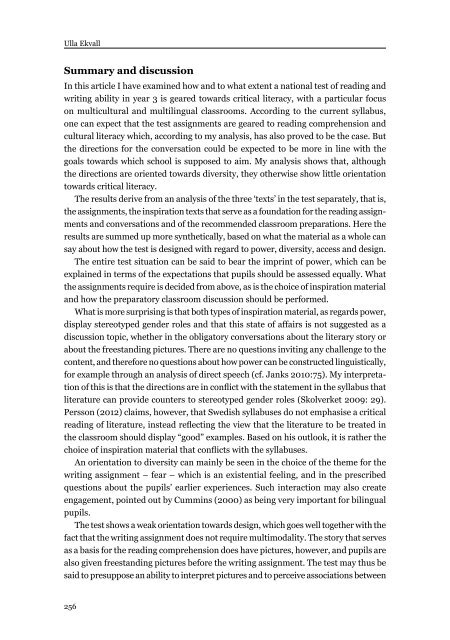Download issue - Umeå universitet
Download issue - Umeå universitet
Download issue - Umeå universitet
Create successful ePaper yourself
Turn your PDF publications into a flip-book with our unique Google optimized e-Paper software.
Ulla Ekvall<br />
Summary and discussion<br />
In this article I have examined how and to what extent a national test of reading and<br />
writing ability in year 3 is geared towards critical literacy, with a particular focus<br />
on multicultural and multilingual classrooms. According to the current syllabus,<br />
one can expect that the test assignments are geared to reading comprehension and<br />
cultural literacy which, according to my analysis, has also proved to be the case. But<br />
the directions for the conversation could be expected to be more in line with the<br />
goals towards which school is supposed to aim. My analysis shows that, although<br />
the directions are oriented towards diversity, they otherwise show little orientation<br />
towards critical literacy.<br />
The results derive from an analysis of the three ‘texts’ in the test separately, that is,<br />
the assignments, the inspiration texts that serve as a foundation for the reading assignments<br />
and conversations and of the recommended classroom preparations. Here the<br />
results are summed up more synthetically, based on what the material as a whole can<br />
say about how the test is designed with regard to power, diversity, access and design.<br />
The entire test situation can be said to bear the imprint of power, which can be<br />
explained in terms of the expectations that pupils should be assessed equally. What<br />
the assignments require is decided from above, as is the choice of inspiration material<br />
and how the preparatory classroom discussion should be performed.<br />
What is more surprising is that both types of inspiration material, as regards power,<br />
display stereotyped gender roles and that this state of affairs is not suggested as a<br />
discussion topic, whether in the obligatory conversations about the literary story or<br />
about the freestanding pictures. There are no questions inviting any challenge to the<br />
content, and therefore no questions about how power can be constructed linguistically,<br />
for example through an analysis of direct speech (cf. Janks 2010:75). My interpretation<br />
of this is that the directions are in conflict with the statement in the syllabus that<br />
literature can provide counters to stereotyped gender roles (Skolverket 2009: 29).<br />
Persson (2012) claims, however, that Swedish syllabuses do not emphasise a critical<br />
reading of literature, instead reflecting the view that the literature to be treated in<br />
the classroom should display “good” examples. Based on his outlook, it is rather the<br />
choice of inspiration material that conflicts with the syllabuses.<br />
An orientation to diversity can mainly be seen in the choice of the theme for the<br />
writing assignment – fear – which is an existential feeling, and in the prescribed<br />
questions about the pupils’ earlier experiences. Such interaction may also create<br />
engagement, pointed out by Cummins (2000) as being very important for bilingual<br />
pupils.<br />
The test shows a weak orientation towards design, which goes well together with the<br />
fact that the writing assignment does not require multimodality. The story that serves<br />
as a basis for the reading comprehension does have pictures, however, and pupils are<br />
also given freestanding pictures before the writing assignment. The test may thus be<br />
said to presuppose an ability to interpret pictures and to perceive associations between<br />
256

















